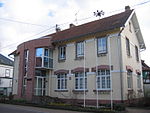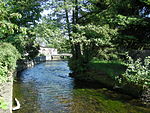Réacteur Université de Strasbourg
Argonaut class reactorDefunct nuclear reactorsScience and technology in FranceUniversity of Strasbourg
The Réacteur Universitaire de Strasbourg (RUS) was a 100 kW thermal Argonaut-class reactor built at the University Louis-Pasteur, located in the commune of Schiltigheim near Strasbourg. RUS went critical on 22 November 1966 and ended operations on 31 May 1995. Its decommissioning was finalized in 2009.
Excerpt from the Wikipedia article Réacteur Université de Strasbourg (License: CC BY-SA 3.0, Authors).Réacteur Université de Strasbourg
Route d'Oberhausbergen, Strasbourg Cronenbourg
Geographical coordinates (GPS) Address Nearby Places Show on map
Geographical coordinates (GPS)
| Latitude | Longitude |
|---|---|
| N 48.6 ° | E 7.7 ° |
Address
Route d'Oberhausbergen 222
67206 Strasbourg, Cronenbourg
Grand Est, France
Open on Google Maps










